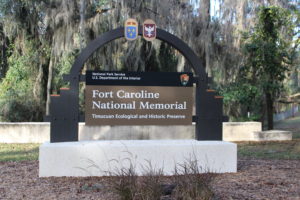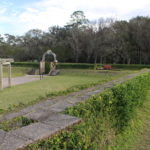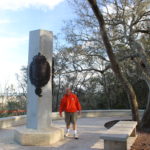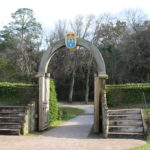 On our days off, Tom and I continue to explore the areas around us, especially trying to visit National Park sites nearby. Recently we headed south of Jacksonville to visit the Timucuan Ecological and Historic Preserve.
On our days off, Tom and I continue to explore the areas around us, especially trying to visit National Park sites nearby. Recently we headed south of Jacksonville to visit the Timucuan Ecological and Historic Preserve.
Timucuan has five distinct parts to the park. It is the only Ecological Preserve in the National Park system. The Theodore Roosevelt Area is a 600-acre treasure of hardwood forest, wetlands, and scrub vegetation. There are miles of thickly wooded nature trails, grassland that supports both water and land animals, and ancient piles of discarded oyster shells which yield clues about the extinct Timucuan culture. Willie Browne, the last private owner of the 600 acres, donated this land to the National Park. He believed that the people who lived in the urban sprawl of Jacksonville needed a quiet, peaceful, natural place to get away from the city.
Another part of Timucuan is the Kingsley Plantation. Zephaniah Kingsley bought the plantation in 1814 and owned it until 1837. The Kingsley family moved to Florida while it was still a Spanish territory because Zephaniah was married to Anna, a former slave. She actively participated in plantation management. The plantation produced Sea Island cotton, citrus, sugar cane, and corn. Kingsley continued to acquire property in north Florida and eventually possessed more than 32,000 acres and more than 200 slaves. You can explore the grounds at Kingsley Plantation, which include the slave quarters, barn, waterfront, plantation house, kitchen house, and interpretive garden. You can also tour of the plantation house on the weekends.
A third area of Timucuan is American Beach, established in 1935 for African Americans who were barred from most of the beaches in Florida. American Beach provided African Americans with beach access in a resort atmosphere. The National Park owns 8.5 acres of the beach on the south end of Amelia Island. The rest of the beach area is private property.
The fourth area of Timucuan is Cedar Point, located at the south end of Black Hammock Island. The 400 acres of Cedar Point hosts a wide range of north Florida ecosystems. There are upland hammocks and salt marsh habitats. It is an excellent place for birding and the only boat ramp in the Preserve.
Fort Caroline is the fifth area of Timucuan and the place Tom and I were most interested to see. The fort is a small reproduction of the only French colony on the East Coast. Three hundred colonists, mostly Huguenots (Protestants), left France in 1564 and established a settlement at Fort Caroline. The next year another 600 settlers arrived. In 1565 the Spanish established St. Augustine, and the two colonies fought for Florida. The Spanish were victorious, killing 400 French soldiers and all except 60 of the women and children. The French left Florida and did not return.
Tom and I checked out the Visitors Center and explored the small fort, admiring the view of the St. Johns River. We also walked the nature trail up the highest bluffs we have experienced in this part of the world.
Timucuan is a large and beautiful National Ecological and Historic Preserve. The many parts means that you can return again and again and always find something new.




2 comments